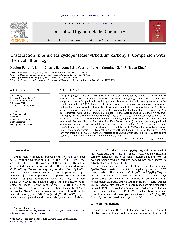摘要
The Cp(2)Rh(2)(CO)(n) (n = 4, 3, 2, 1) derivatives have been examined by density functional theory using the BP86 and MPW1PW91 functionals. The known tricarbonyl Cp(2)Rh(2)(CO)(3) is predicted to have a singly bridged structure with a predicted Rh-Rh single bond distance of similar to 2.70 angstrom in close agreement with the experimental value of 2.68 angstrom, determined by X-ray crystallography. In contrast to the cobalt analog, no evidence for a triply bridged Cp(2)Rh(2)(mu-CO)(3) structure was found. The known dicarbonyl Cp(2)Rh(2)(CO)(2) is predicted to have a doubly bridged structure with a predicted Rh=Rh double bond distance of 2.58 angstrom in close agreement with the experimental Rh=Rh double bond distance of 2.564 angstrom, found by X-ray crystallography for the permethylated derivative (eta(5)-Me(5)C(5))(2)Rh(2)(mu-CO)(2). The monocarbonyl Cp(2)Rh(2)(CO) is predicted to have a four-electron donor bridging carbonyl group with a Rh-O distance of similar to 2.5 angstrom and a Rh=Rh double bond distance of similar to 2.54 angstrom. This differs from Cp(2)Co(2)(CO) which was previously predicted to have only a two-electron donor bridging carbonyl group with a long Co center dot center dot center dot O distance and a short Co Co distance of similar to 2.0 angstrom suggesting a formal triple bond. For Cp(2)Rh(2)(CO)(4) doubly bridged trans and cis isomers were found within similar to 1.0 kcal/mol in energy with non-bonding Rh center dot center dot center dot Rh distances of similar to 3.2 angstrom. However, these Cp(2)Rh(2)(CO)(4) isomers are predicted to be unstable with respect both to CO loss to give Cp(2)Rh(2)(CO)(3) and to fragmentation into two CpRh(CO)(2) units.
